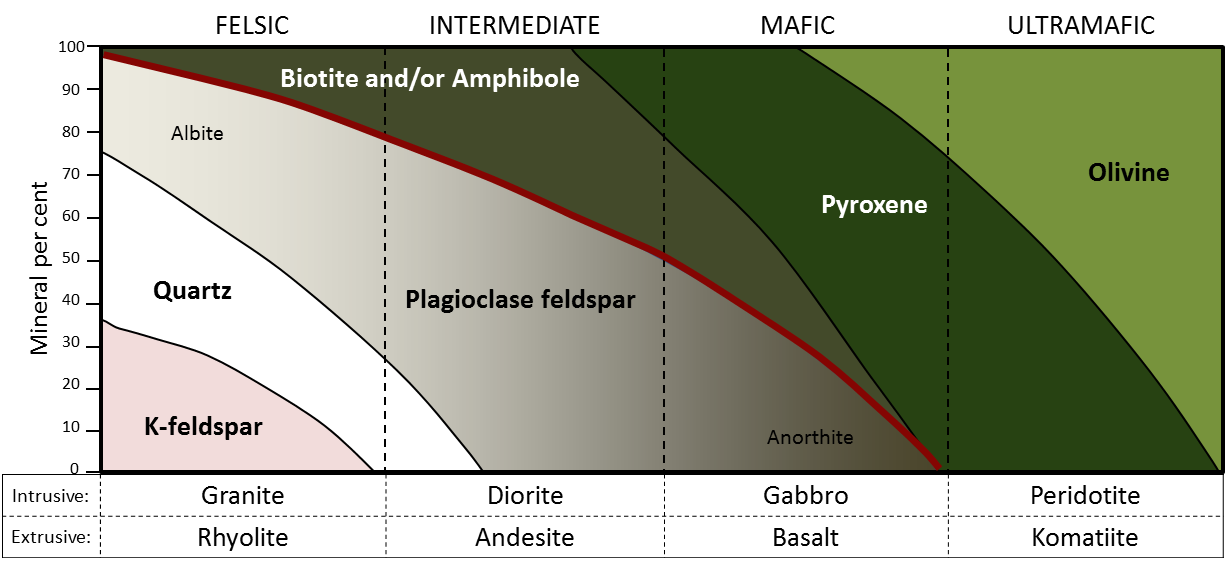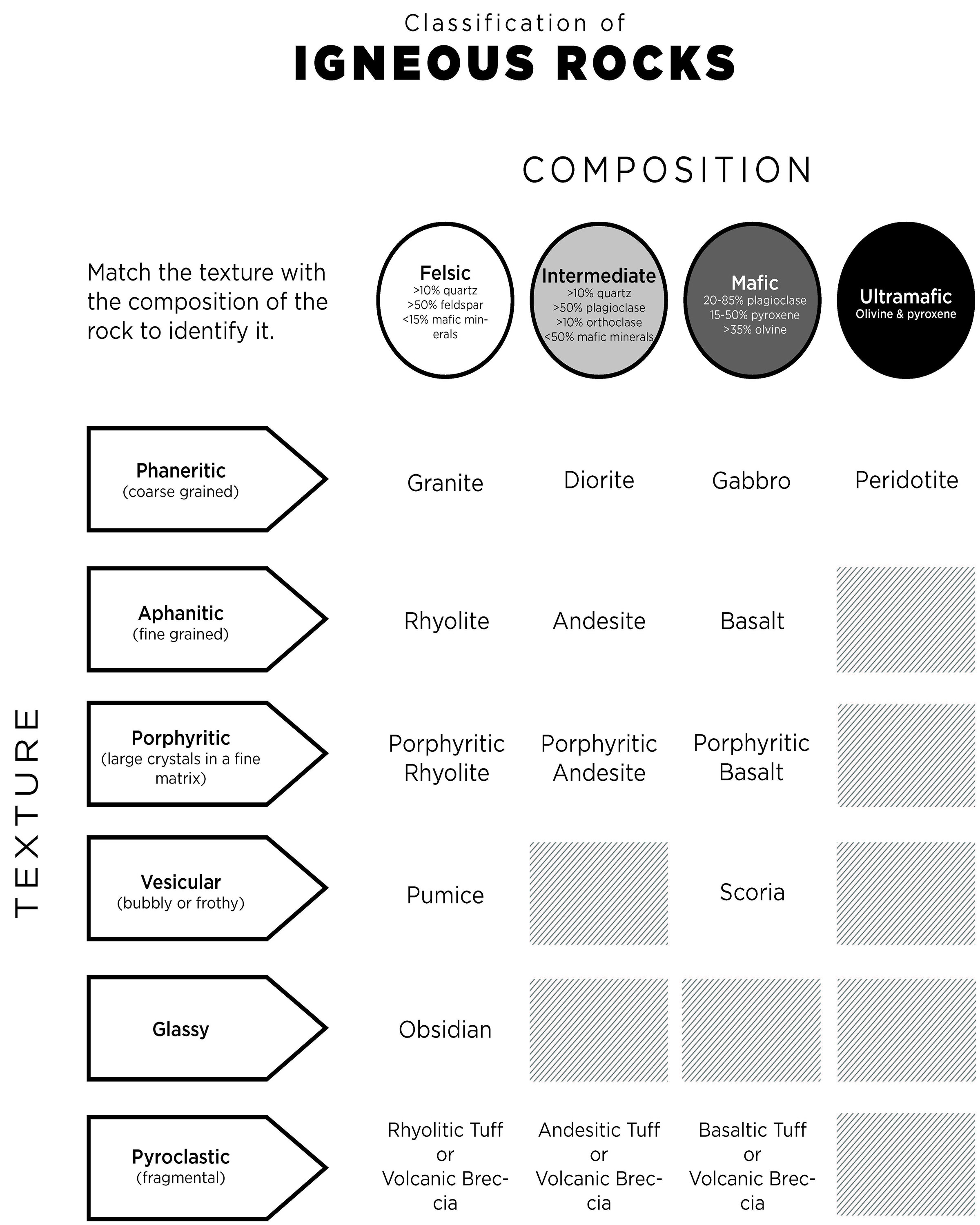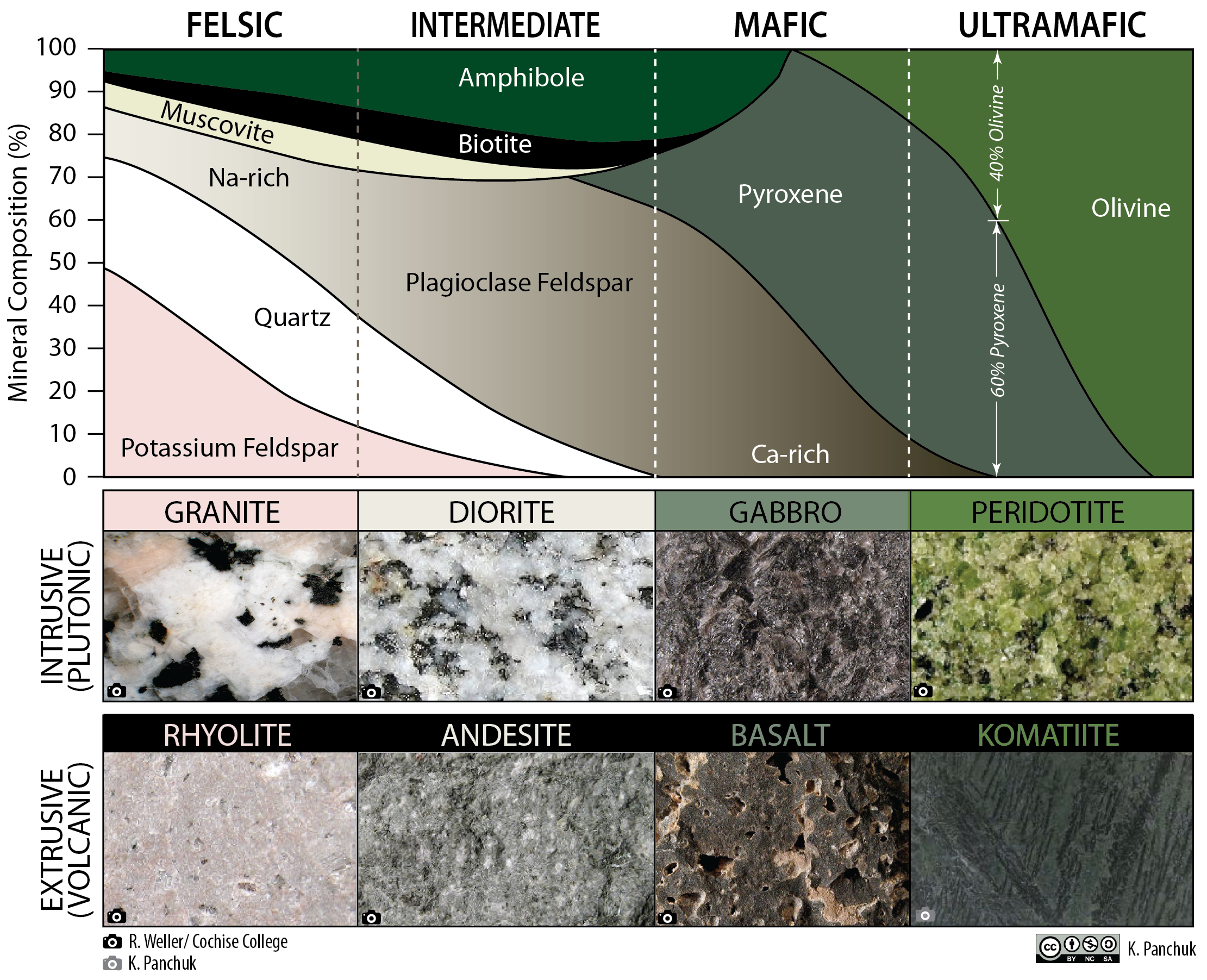What Words Are Used to Describe the Igneous Rocks Composition
Feldspars quartz or feldspathoids olivines pyroxenes amphiboles and micas are all essential minerals inside the formation of virtually all igneous rocks and they may be primary to the type of these rocks. An important feature to note on this diagram is the red.

3 4 Classification Of Igneous Rock Physical Geology 2nd Edition
Many different types of igneous rocks can be produced.

. Diorite granite pegmatite are examples of intrusive igneous rocks. Texture relates to how large the individual mineral grains are in the final solid rock. Igneous rock that forms from lava.
Igneous rocks are classified according to their texture and composition. They include quartz K-feldspar and muscovite. Igneous rock is formed through the cooling and solidification of magma or lava.
Texture refers to the size and arrangement of the minerals or grains that make up a rock. Which rock-forming minerals are common in igneous rocks. Felsic intermediate mafic and ultramafic based on either their chemistry or their mineral composition.
As has already been described igneous rocks are classified into four categories based on either their chemistry or their mineral composition. A mass of rock particles grains of minerals or both. AnswerSilicate type of minerals are the most common minerals found in igneous rocks which include silicate minerals like feldspars plagioclase feldspar potassium feldsparc.
Rock formed when hot liquid rock or magma cools and solidifies. They are simply the rocks formed through heating then followed by cooling. Which rock-forming minerals are common in sedimentary rocks.
Phaneritic aphanitic porphyritic glassy pyroclastic and pegmatitic. A mineral consisting of fine needle-like crystals. In this sense igneous rocks are formed when molten rock magma solidifies either underneath the earths crust to form plutonic intrusive igneous rocks or on the surface of the earth to form volcanic extrusive igneous rocks.
The term used to describe the composition of igneous rocks that are light in color less dense and rich in elements like potassium aluminum silicon and sodium. Briefly describe the most likely crystallization and texture of the rock. Forced while molten through cracks in the earths surface.
Here are the common terms for defining texture. Rock formed by the solidification of molten magma. Mafic rocks are made of dark-colored higher-density minerals such as olivine and pyroxene.
Those which began their lives below the surface are called intrusive rocks while those which cooled on the surface are referred to as extrusive rocks. The texture of a rock provides a clue whether the magma cooled fast or slowly and where the rock was formed. The heated material is the molten.
The diagram in Figure 341 can be used to help classify igneous rocks by their mineral composition. There are six main types of textures. You are studying a sample of igneous rock.
Igneous rocks that form beneath the Earths surface or in the Earth. Composition refers to both the types of minerals within a rock and the overall chemical makeup of the rock the two are obviously related. Irregular mass of crystals.
Intrusive rocks are formed from magma that. The key factors to use in determining which rock you have are the rocks texture and composition. Intrusive igneous rocks are rocks that crystallize below the earths surface resulting in large crystals as the cooling takes place slowly.
The two main categories of igneous rocks are extrusive and intrusive. A brilliant luster like that of a diamond. Igneous rocks are classified according to their mineral content.
Extrusive rocks are formed on the surface of the Earth from lava which is magma that has emerged from underground. The diagram in Figure 316 can be used to help classify igneous rocks by their mineral composition. Rocks with such a texture are called crystalline igneous rocks.
Other igneous rock forms from lava that cools quickly on Earths surface. The magma can be derived from partial melts of existing rocks in either a planets mantle or crust. The main two categories of igneous rocks are known as extrusive and intrusive rocks.
The mineral compositions of igneous rocks are usually described as being felsic intermediate mafic or ultramafic as examples see Figure 47 and Figure 48. Rocks that consist of minerals that grow when a melt solidifies interlock like pieces of a jigsaw puzzle figure above a. Intermediate rocks are roughly even mixtures of felsic.
As has already been described igneous rocks are classified into four categories. Felsic intermediate mafic and ultramafic. In general igneous rocks formed underground have mineral of larger size than the igneous rocks formed above the ground.
Igneous textures are used by geologists in determining the mode of origin igneous rocks and are used in rock classification. Classify the rock by type and composition. One may also ask what are the two classification of igneous rocks.
Felsic rocks are made of light-colored low-density minerals such as quartz and feldspar. Igneous Rocks by Composition. The following terms are commonly used to describe the texture of igneous rocks.
The sample has just a few specks of dark-colored minerals. The terminology Igneous means fire or heat. Igneous rock derived from the Latin word ignis meaning fire or magmatic rock is one of the three main rock types the others being sedimentary and metamorphic.
All different minerals gift are regarded as nonessential in nearly all igneous rocks and are referred to as accent minerals. Ultramafic rocks are dominated by olivine andor pyroxene. Mafic rocks are dominated by plagioclase and pyroxene even if you cant see them with the naked eye and smaller amounts of olivine.
Igneous Rock Textures Igneous Rock Compositions. Textures and types of igneous rocks. Sand gravel crushed stone or rock that forms the major part of concrete.
In most cases the resulting grain size depends on how quickly the magma cooled.

4 1 Classification Of Igneous Rocks Geosciences Libretexts

7 3 Classification Of Igneous Rocks Physical Geology First University Of Saskatchewan Edition
No comments for "What Words Are Used to Describe the Igneous Rocks Composition"
Post a Comment